Mastering the Naish Kite Pump: A Complete Guide
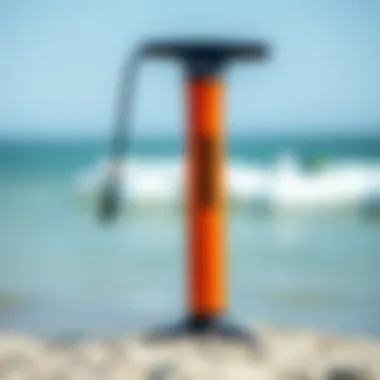
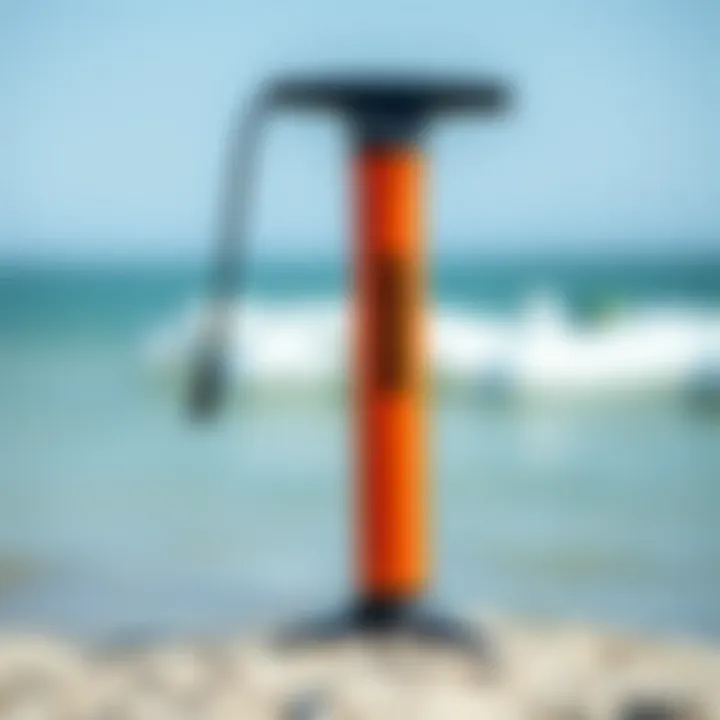
Intro
Kiteboarding can often seem like a high-speed dance with the wind, where the kite becomes an extension of oneself. At the heart of this exhilarating experience lies one crucial yet often overlooked tool: the Naish kite pump. This device is not merely a pump; it’s the first step in harnessing the elements and propelling oneself across the water. A reliable pump ensures that your kites are inflated correctly, enabling better control and optimal performance on the waves.
In the following sections, we will explore the essential aspects of mastering the Naish kite pump, including its design and features, maintenance tips, and even comparisons with other brands. The aim is to provide you with a thorough understanding of how this simple tool can drastically enhance your kiteboarding experience. Knowledge is power, and being equipped with the right information about your gear can make a world of difference out on the water.
Gear Selection
When it comes to kiteboarding, selecting the right gear is fundamental. The right kite and board, complemented by proper inflation techniques using the Naish pump, can elevate an ordinary day on the water into something unforgettable. Let’s dive into the specifics of gear selection.
Types of Kites
Understanding the different types of kites is crucial for any kiteboarder. Each kite serves a different purpose depending on wind conditions and rider skill levels. For example, C-kites are designed for pro riders who like aggressive tricks, while bow kites are more stable and user-friendly, making them great for beginners. Familiarity with your kite's characteristics and how they interact with your pump will give you an edge.
- C-Kites: Ideal for experienced riders focused on freestyle and tricks.
- Bow Kites: Offer more stability and lift, suitable for novices.
- Delta Kites: These provide versatility and are good for a variety of conditions.
Choosing the right kite for your riding style and skill level can improve both comfort and performance on the water.
Choosing the Right Board
Selecting a board that complements your kite is just as vital. Boards come in various shapes and sizes, and each offers distinct advantages depending on riding conditions. For example, a shorter board may perform better in choppy waters, while longer boards provide stability in calmer conditions. It's essential to consider your skill level, riding style, and the kind of conditions you most often face.
- Directional Boards: These are best for wave riding, allowing seamless navigation through swells.
- Twin-tips: Favorited by many for their maneuverability and ease of use.
- Freestyle Boards: Specifically designed for tricks and jumps.
Equipped with the right kite and board, plus an understanding of how the Naish pump factors into the equation, you’ll be better prepared to enjoy kiteboarding.
"The right gear can make the difference between simply riding the water and truly mastering it."
In the next section, we’ll delve into Skill Development, focusing on essential techniques and tips to progress in your kiteboarding journey.
Intro to Kite Pumping
Kite pumping may not seem like the main event when discussing kiteboarding, but it lays the groundwork for a great experience on the water. Think of kite pumping as the unsung hero of your kiteboarding setup. Without the right inflation of your kite, all the planning and anticipation for a day in the sun instantly goes down the drain.
Here’s why understanding kite pumping is crucial.
Kiteboards often require a specific level of pressure to perform optimally. If the kite isn’t pumped up right, the rider could end up battling with control, resulting in unresponsive maneuvers that can leave one floundering around. In essence, proper inflation translates to better lift and stability when soaring through the air. When you know what you’re doing with your Naish kite pump, your kiteboarding becomes less of a chore and more of a thrill.
What’s more, the efficiency of the pump itself plays a fundamental role in how quickly you can get on the water. The Naish kite pump, known for its versatility and durability, is designed to help enthusiasts get the job done with as much ease as possible. Therefore, time spent mastering this tool will pay off tenfold during your kiteboarding sessions.
Moreover, the nuances of kite pumping—like understanding the way air chambers inflate and the pump's dual-action features—are essential to achieving that perfect tension. Unlike the average Joe with a basic pump, a savvy rider knows to take advantage of the innovative aspects of their Naish pump, enhancing not just inflation but the overall kite performance.
So, as we delve deeper into this guide, keep in mind that kite pumping is not just about filling up your kite. It’s about setting the foundation for your kiteboarding adventure and ensuring that every session brings joy instead of frustration.
Understanding the Basics
Diving into the nuts and bolts of kite pumping starts with grasping why it matters. Understanding how kite pumps work will give any rider an edge. Many users might not think about what happens inside a pump but consider it as a direct pathway for air to enter the kite.
When using a kite pump, there are generally a few basic principles at play:
- Air Compression: The pump compresses air into the kite, creating pressure. This pressure helps to shape and stabilize the kite while in action.
- One-way Valve System: Most pumps, including the Naish model, utilize this feature, ensuring that air stays inside the kite while preventing it from escaping.
- Dual Action Capability: A more advanced characteristic of specific pumps, where air is pushed in during both the up and down strokes of the pump handle. This can significantly speed up inflation time.
By familiarizing yourself with these core concepts, you can appreciate how even the smallest details can impact performance.
Importance of Inflation
When it comes to kiteboarding, achieving the right level of inflation is critical. A kite that’s not fully inflated can struggle against the wind and react sluggishly to your commands. Optimizing your kite’s air pressure not only affects your control and stability but also plays a crucial role in safety.
To illustrate the importance, consider this:
"Proper inflation is like the foundation of a house; neglecting it can lead to a shaky experience."
Here are a few key considerations concerning inflation:
- Performance: A well-inflated kite offers enhanced lift and smoother rides. This makes it easier to perform jumps, spins, and other tricks
- Safety: A kite that’s too deflated might fold in on itself, causing unpredictable flight patterns that could be dangerous, especially in strong winds.
- Durability: Excessive or inadequate inflation can wear down a kite's materials, potentially leading to tears or premature failure. Taking care during this process can extend the life of your kite.
In short, understanding the importance of inflation can drastically affect your overall experience and proficiency in kiteboarding. This knowledge, when paired with a quality pump like the Naish, sets the stage for all the thrills and spills you'll encounter on the water.
Naish Kite Pump Overview
The Naish kite pump is not just a piece of equipment; it’s a vital asset for kiteboarding enthusiasts. Understanding its significance in the kiteboarding experience can greatly influence overall performance and satisfaction on the water. Whether you're a seasoned pro or just getting your feet wet in the sport, the right kite pump can make a world of difference.
Navigating the waters with a well-inflated kite can enhance responsiveness and agility, allowing for smoother navigation through waves and jumps. The Naish kite pump, in particular, stands out for its innovative features that cater to the specific demands of kiteboarding. From ease of use to durability, its design encourages an efficient inflation process, which is crucial for maximizing ride time.
Below are some key points that illustrate the importance of the Naish kite pump:

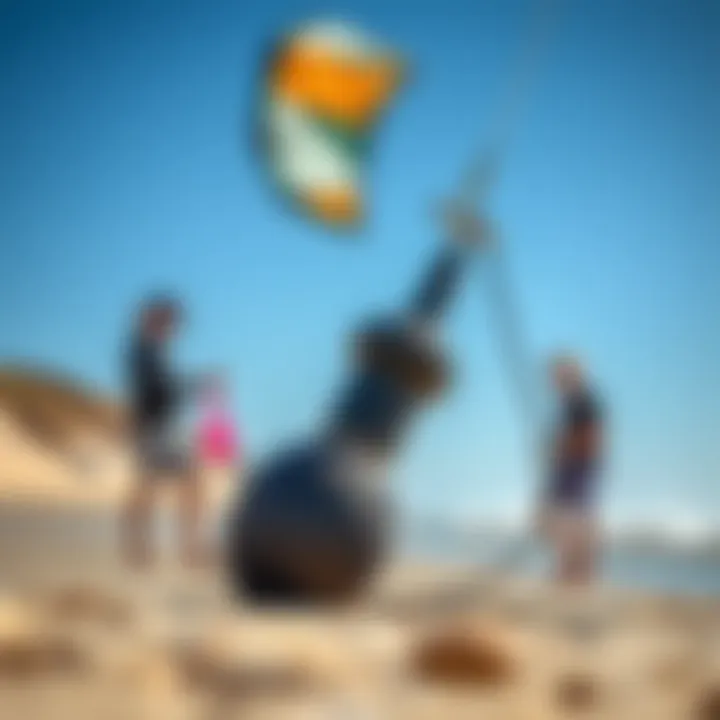
- Efficiency in Inflation: Many kiteboarders find that the dual-action pumping mechanism simplifies the inflation process, allowing for quicker preparation and more time spent riding.
- Durable Construction: Built with quality materials, the Naish pump emphasizes longevity, ensuring it stands up against the rigors of the sport all while remaining light enough for easy transport.
- User-Friendly Design: Ergonomically designed handles and a stable base mean that even inexperienced users can pump their kites confidently without the fear of equipment failure.
By examining these features, it becomes clear that the Naish kite pump plays a significant role in enhancing the kiteboarding experience. Below, the focus shifts to key design attributes that make this pump a standout in the competitive kiteboarding market.
Design Features
The design of the Naish kite pump is carefully crafted to enhance its ease of use and overall functionality in various wind conditions. One of the most notable attributes is the dual-action mechanism, which allows the pump to inflate during the up and down stroke. This design drastically increases efficiency, resulting in reduced time spent pumping and more time out on the water.
Additionally, the pump includes an easy-to-read pressure gauge, ensuring that you can attain the right pressure for optimal kite performance without guesswork. The nozzle is also engineered to fit snugly into various kite valve types, reducing the risk of air leaks during inflation.
Materials and Construction
Naish takes materials and construction seriously, incorporating high-quality components into the pump's construction. The pump body is made from high-density polyethylene, providing excellent resistance against wear and tear. This means that, no matter how many times you pump up your kite, the pump will continue to function reliably.
The hose is designed to handle high pressure while remaining flexible enough to prevent kinks that could impede airflow. This flexibility is crucial when you're on the go, needing to pack and unfold gear quickly. The ergonomic handles are not just a design luxury; they create a solid grip, which is vital when you're pumping with vigor.
If you're considering the purchase of a Naish kite pump, it is beneficial to do further research on its advantages compared to other brands in the kiteboarding arena. Here are some relevant links for your reference:
Embracing the right equipment that caters to your needs can elevate your kiteboarding experience tremendously. With the Naish pump, outfitting your kite becomes a breeze, allowing you to focus on what truly matters—the ride.
Functionality of Naish Kite Pump
Understanding the functionality of the Naish kite pump is crucial for any kiteboarding enthusiast. It’s not just about getting air into your kite; it's about ensuring optimal performance right from the moment you hit the beach. When every second counts and wind conditions can be tricky, the efficiency and features of your pump can make all the difference.
Dual Action Mechanism
The Naish kite pump stands out primarily due to its dual action mechanism, which sets it apart in a competitive market. In simple terms, this feature allows the pump to push air into the kite both on the upstroke and the downstroke. This means that you can inflate your kite in half the time compared to traditional single-action pumps.
Think of it like this: if you’re in a race against time, wouldn’t you want a pump that does double duty? With each pump of the handle, you’re not just working harder but smarter. Kiteboarding often relies on quick set-ups, and having a pump that can blow air in on both strokes means you’ll be on that water faster, ready to tackle those waves.
- Benefits of Dual Action:
- Time-saving: Inflate your kite quicker, allowing more time for riding.
- Effort: Requires less physical effort to achieve full inflation.
- Pressure consistency: Maintains even pressure throughout the kite, leading to better control on the water.
Pressure Efficiency
Next up is pressure efficiency, which is another area where the Naish kite pump excels. The pump's design facilitates the building of pressure without necessarily requiring Herculean strength from the user. You may find that your arms don’t tire as quickly, which is a huge plus when you're trying to keep up with friends or prepare for a competition.
Ensuring that your kite is inflated to the right pressure is vital. Too little pressure, and your kite may suffer from poor performance; too much pressure, and you risk damaging it. The Naish pump often comes equipped with pressure gauges, allowing you to monitor your inflation accurately. This small addition can save you from potential mishaps and enhance the durability of your gear.
- Key Aspects of Pressure Efficiency:
- Consistent Performance: Proper inflation translates to optimal kite responsiveness.
- Durability: Reduces risk of punctures and material fatigue caused by improper inflation levels.
- User-friendly technology: Many models offer easy-to-read gauges for accurate monitoring.
"Inflating a kite isn’t just a chore; it’s an art. With the right pump, every pump stroke counts in creating your perfect ride."
When considering the functionality of the Naish kite pump, it becomes clear how its dual action and appropriate pressure handling overall contributes to a smoother, more enjoyable experience on the water. These elements not only improve efficiency but also enhance the kiteboarding adventure each time you hit the surf.
Using the Naish Kite Pump Effectively
Using the Naish kite pump effectively is essential for maximizing your kiteboarding experience. This pump doesn't just inflate your kite; it plays a crucial role in your overall performance on the water. Well-inflated kites allow for better control, enhanced safety, and increased responsiveness to environmental conditions. Understanding how to use the pump to its fullest potential ensures that you’re not just going through the motions, but truly elevating your time on the waves.
Step-by-Step Inflation Process
Inflating your kite sounds straightforward, but there are nuances that can make a world of difference. Here’s a clear guide to help you get it right every single time:
- Prepare Your Gear: Before heading out, lay your equipment in a clean, dry area. Ensure your Naish pump is in good working condition.
- Attach the Hose: Connect the hose to the pump, making sure it fits snugly. A loose connection can lead to air leaks, which defeat the purpose.
- Locate the Inflate Valve on the Kite: This is often colored or marked for easy identification. Ensure it's clean and free of sand.
- Insert the Pump Nozzle: Align the nozzle into the inflate valve. Some find it helpful to twist it slightly to lock it in place.
- Begin Pumping: For optimal inflation, use a dual action technique, allowing the pump to inflate both on the up and down strokes. This maximizes air intake without exhausting you right off the bat.
- Monitor Pressure: Every kite has specific pressure requirements. It’s wise to have a pressure gauge on hand as a guide.
- Finish Up: Once you feel the resistance, remove the nozzle, quickly cover the valve, and fully seal it. This prevents any air loss.
- Visual Check: Look over the entire kite to ensure no areas are sagging or under-inflated.
This step-by-step guide streamlines the process, making it efficient without sacrificing quality. Each action contributes to a solid start on the water.
Common Errors to Avoid
Inflating your kite might seem simple, but there are pitfalls that can hinder your performance. Here’s a list of common mistakes:
- Overinflation: It’s tempting to pump vigorously, but too much air can lead to damage. Every kite has a recommended pressure, respect it.
- Skipping the Pre-Check: Not checking your pump’s condition can lead to frustrations. A small tear or hole can result in inefficient pumping or failure altogether.
- Neglecting Valve Care: Rolling on sandy or rocky surfaces might contaminate the valve. Always keep it clean to ensure a proper seal during inflation.
- Improper Hose Connection: A loose connection can release air. Make sure it's secure.
- Inflating in Wind: If possible, avoid inflating in high winds. This can lead to the kite catching wind and potentially causing it to escape while inflating.
"Paying attention to the little things can save you major headaches later!"
By avoiding these common errors, you can ensure that your kite is not just inflated but ready to perform, setting you up for a successful session on the water.
Maintenance Guidelines
Proper maintenance of your Naish kite pump is crucial for ensuring its longevity and optimal performance. Like any tool, if you don’t take care of it, you might end up with a malfunctioning device just when you need it the most. This section dives into the essential aspects of maintaining your pump, focusing on cleaning procedures and storage recommendations that can greatly extend the life of your equipment.
Cleaning and Care
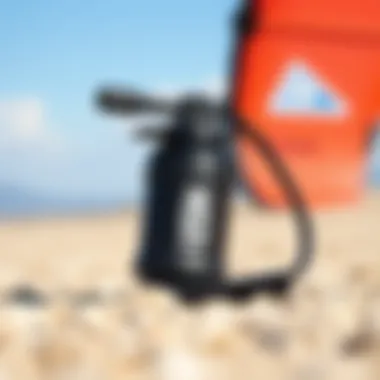
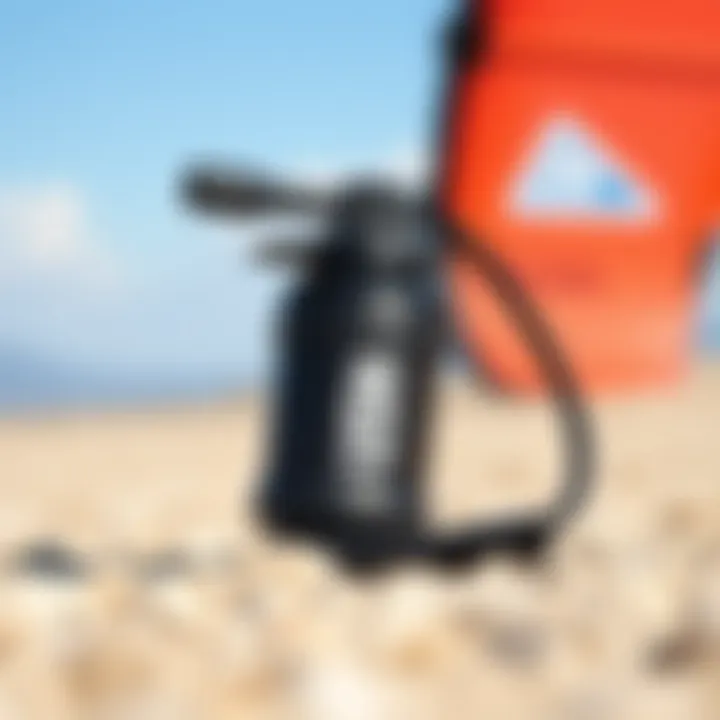
Keeping your Naish kite pump clean is not just about appearance; it significantly affects its functionality. After a day of kiteboarding, the pump can accumulate sand, salt, and moisture—all elements that can hinder its operation over time.
Here are a few simple steps to effectively clean and care for your pump:
- Rinse with Fresh Water: Directly after use, flush out any salt and sand by rinsing the pump with fresh water. Take care to not immerse it fully, just spray or wipe down.
- Use a Soft Cloth: Wipe the entire surface with a soft cloth. This will help in removing any remaining debris and preventing scratches that might compromise the pump's integrity.
- Check Valves and Hoses: Frequently inspect the valves and hoses for any obstructions or build-up. Use a gentle brush to clean these areas without causing damage.
- Auto Repair Solutions: In case of any small scratches or minor damages, some kiteboarders recommend using specialized repair patches specifically designed for inflatables, ensuring that your pump maintains its full functionality.
Following a regular cleaning routine will not only fine-tune your pump’s performance but also allow you to spot issues before they escalate into bigger problems.
Storage Recommendations
Once you've cleaned your Naish kite pump, proper storage is the next step to guarantee its shape and efficiency. Here are some foolproof tips:
- Cool and Dry Place: Avoid storing your pump in direct sunlight or in humid conditions. Sunlight can weaken materials, while moisture can cause rust and mold. A shaded, dry spot, such as a gear bag, works best.
- Keep it Upright: When storing, keep the pump upright. This prevents bending or damaging the hose and ensures no residual moisture collects.
- Use a Protective Cover: Consider using a protective cover or a bag specifically designed for your pump. This adds extra protection against dust and physical damage when not in use.
- Avoid Clutter: Keep the pump away from heavy equipment or items that can fall or press against it. This can cause not only physical damage but also create leaks in the valve or hose.
By taking these maintenance steps seriously, you’ll save yourself time and potential frustration later. The added time taken in cleaning and appropriate storage of the Naish kite pump directly correlates to its reliability when you're out on the water.
Comparative Analysis of Kite Pumps
In the realm of kiteboarding, the right pump can make or break your day on the water. Kite pumps come in various shapes and sizes, each boasting its own set of features. A comparative analysis of these pumps is not just a neat aspect of gear selection; it’s a critical step toward elevating your kiteboarding experience. Understanding how the Naish kite pump stacks up against competing brands offers insights not merely into performance but also durability, ease of use, and overall value.
When we talk about comparative analysis, we’re diving into several core elements:
- Design Efficiency: This looks at how user-friendly, lightweight, and portable a pump is.
- Air Volume Capacity: This refers to how much air a pump can deliver with each stroke, crucial for faster inflation.
- Build Quality: The longevity and sturdiness of the pump materials are paramount for long-term use.
- Pressure Capabilities: Higher pressure means your kite can achieve optimal performance.
This examination helps kiteboarders, instructors, and event organizers make informed decisions that affect performance and enjoyment on the water. Factors like inflation speed and how the pump handles varying wind conditions can directly influence your time spent kiteboarding.
Naish vs. Other Brands
When comparing the Naish kite pump with others available on the market, several notable distinctions emerge. Naish pumps often feature a dual-action system that can fill the kite with air on both the upstroke and the downstroke, creating a smooth and efficient inflating experience. This dual mechanism sets Naish apart from some entry-level brands that might only work effectively during one phase of the pumping cycle.
Another key aspect is the ergonomic design. With its cushioned handle and a lightweight structure, the Naish pump offers comfort while reducing fatigue – a stark contrast to the sometimes bulky, hard-grip handles found in off-brand options.
Here’s a quick breakdown of how Naish compares with a few popular competitors:
- Naish Kite Pump: Dual-action, ergonomic design, lightweight
- Bestway Kite Pump: Single-action, heavier construction
- Airush Kite Pump: Dual-action, but less portable
Performance Metrics
When assessing the performance metrics of the Naish pump against others, consider the following aspects:
- Inflation Time: A key metric for any kiteboarder. Time saved during inflation translates to more time on the water. The Naish pump typically inflates kites faster than many of its competitors, often requiring fewer strokes.
- Pressure Maintenance: Maintaining pressure is crucial for kite performance. The Naish pump is known to maintain the pressure effectively, minimizing the risk of deflation due to leaks compared to some budget brands.
- Versatility: Not only does the Naish pump work well with Naish kites, but its attachments also allow it to be used for various other brands, increasing its usability.
- Durability: Materials used in construction impact how well a pump stands up to the elements. Naish pumps, made from resilient materials, are often less prone to breakage or wear-and-tear than competing pumps.
"Investing in a quality pump is like putting race-tires on a car; it makes all the difference in performance!"
Troubleshooting Common Issues
Understanding how to handle common issues while using the Naish kite pump is crucial for kiteboarders. Proper troubleshooting not only ensures a seamless experience on the water but also prolongs the life of your pump. Let’s dive into some frequent hurdles you may encounter and how to tackle them effectively.
Deflation During Use
Deflation during use is one of the more frustrating experiences when kite pumping. This issue can occur due to various reasons, like loose valves or a worn-out bladder. When you’re out there, the last thing you want is for your kite to lose its shape mid-session.
To avoid such mishaps, check the valve connections before every session. Ensure they’re snug and lock in securely. It helps to have a quick visual inspection of the kite material itself; look for punctures or wear and tear that can lead to air leaks.
A few recommendations to prevent deflation include:
- Inspect your valves regularly: After each session, give them a little twist to make sure they are tight and functional.
- Carry a repair kit: A simple puncture repair can save the day when you're far from the shore.
- Practice makes perfect: Familiarize yourself with the pump functions and do a test inflation at home. This will help you spot problems before you head out.
"Prevention is better than cure"—making these inspections a habit can save you from back-and-forth trips to the beach.
Pressure Loss Solutions
Pressure loss can happen for many reasons: faulty hoses, improper inflation techniques, or malfunctioning pumps. Whatever the cause, knowing how to diagnose and rectify the issue quickly ensures that fun time on the water doesn't grind to a halt. An efficient kite remains a happy kite, and therefore a better performing one.
Some immediate actions to take when you suspect a pressure drop:
- Check for leaks: Run your hand along the seams and valves to detect air escaping. If you hear a hissing sound, you likely have a leak.
- Re-inflate when necessary: Sometimes all it takes is a top-off. If the kite appears soft, don't hesitate to pump more air into it.
- Inspect all connections: Make sure that the hose connects firmly to the pump as well as to the kite. Loose connections mean nothing but trouble.
- Replace worn components: If you frequently experience pressure loss, look into replacing outdated or damaged parts of your pump.
Maintaining the integrity of your equipment should be a top priority, as it directly influences not only your performance but also your overall safety when kiteboarding.
By staying vigilant and proactive about these common challenges, you can ensure that your Naish kite pump serves you well for many sessions to come.
User Testimonials
User testimonials hold significant weight in any discussion about equipment, and when it comes to the Naish kite pump, this is no exception. These real-life experiences provide valuable insights, shedding light on aspects that specifications alone might overlook. By exploring various perspectives, potential buyers can gain a deeper understanding of how the pump performs in different conditions, under various skill levels, and amidst a variety of cercomstances. Without hearing directly from users, one might miss subtleties that can dramatically influence performance on the water.
Diverse Experiences
When kiteboarders share their stories about using the Naish kite pump, they paint a vivid picture of its versatility and reliability. For instance, one seasoned rider from Maui mentioned how the dual action mechanism helped him inflate his kite faster on windy days when every second counts. They emphasized that the pump’s sturdy construction enabled them to rely on it, even after repeated strenuous use.
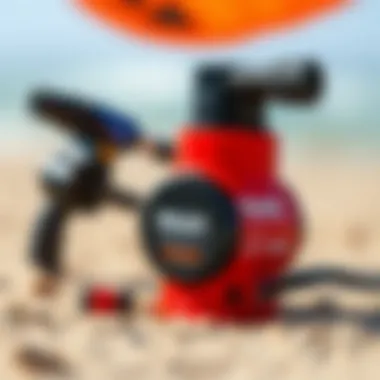
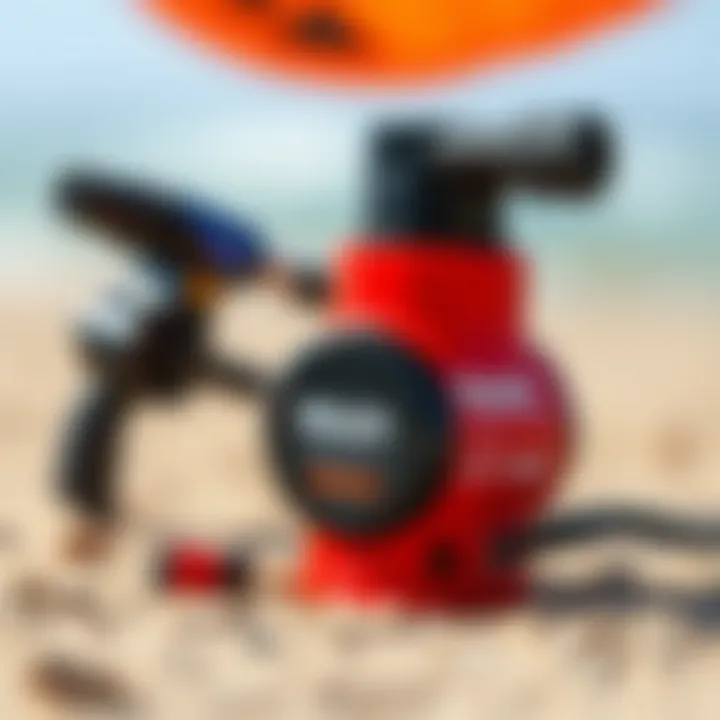
Another user, a beginner from Florida, shared their humble journey of learning to pump a kite. They remarked on how simple and intuitive the Naish pump was, explaining how it eased their path into kiteboarding. They could focus on improving their skills instead of struggling with pump mechanics. Hearing such varied accounts helps prospective users anticipate how the pump might cater to their own needs whether they're starting or seasoned in the sport.
Comparative Feedback
Comparing user feedback across various platforms can yield further insights into the Naish kite pump's standing among its competitors. Enthusiasts often share their experiences on forums like Reddit and social media platforms. For example, several kiteboarders have expressed admiration for the Naish pump's balance of performance and durability when stacked against brands like Cabrinha or Slingshot. What stands out in these conversations is the point about longevity and usability: users often state that while the price of the Naish may be higher at first glance, its longevity and ease of use convert that investment into savings over time.
"The Naish pump has been with me through thick and thin. After countless sessions, I'm still amazed at how well it holds up against the elements," noted one rider from California. They further asserted that the hassle of equipment failure becomes a non-issue, allowing the focus to remain on the ride.
By gathering a robust collection of testimonials, both positive and critical, one can derive a balanced view of the Naish kite pump’s capabilities. Engaging with real-world accounts creates a trustworthy foundation for future buyers, guiding them to make informed choices when investing in tools crucial to their kiteboarding adventures.
Buying Considerations
When it comes to selecting a kite pump, the decision-making process is not just about getting something that inflates your kite. It goes much deeper than that. Understanding the buying considerations is crucial; it can save you money, time and ultimately influence your kiteboarding performance.
Cost vs. Quality
In the realm of kite pumps, the adage "you get what you pay for" often holds true. When it comes to Naish kite pumps, they tend to be on the higher end of the price spectrum for a reason. These pumps are designed with durability in mind, featuring robust materials and superior engineering that many cheaper alternatives simply cannot match.
Here’s what to keep in mind:
- Durability: Higher-cost pumps often use high-quality plastics and metals that withstand the wear and tear of outdoor conditions. A pump that breaks on your first trip can easily turn into a financial sinkhole.
- Performance: While cheaper pumps might do the job, they often have slower inflation rates or lower pressure capabilities. A Naish pump, for instance, offers a dual-action mechanism, allowing for quicker inflation, which is essential when you're racing against the wind.
- Warranty and Support: Spending a little extra on a Naish kite pump usually means you also get better customer support and warranty services. Many budget alternatives come with little to no backup, leaving you in a bind when something goes amiss.
So, while the initial investment in a Naish might feel steep, think long-term. You might be saving money overall by avoiding additional purchases and repairs.
Where to Purchase
Knowing where to buy your Naish kite pump can be almost as important as the decision to buy it in the first place. Here are some options to consider:
- Specialty Kite Stores: These shops often have staff who are well-versed in kiteboarding gear. They can provide insights and might even offer live demonstrations. Local shops can also give you a sense of community and support.
- Online Retailers: Websites like kiteboarding.com and wavezone.com often offer competitive prices and frequent sales. However, be cautious of shipping costs and return policies. It's wise to read reviews and check the seller's reliability before committing.
- Second-Hand Options: Sometimes you might find a gently used Naish pump on platforms like eBay or local classifieds. Just ensure you thoroughly check it for any issues before making a purchase.
- Kiteboarding Events: Attending kiteboarding festivals or events can be a fantastic way to find deals. Vendors often showcase their latest gear, sometimes at discounted prices. Plus, you get to interact with fellow kiteboarders and gather firsthand feedback on what works best.
Whatever route you choose, remember to weigh your options carefully. The right pump can elevate your experience, while the wrong choice can leave you high and dry.
Environmental Impact
Understanding the environmental ramifications of our equipment choices is essential in today’s kiteboarding culture. With global awareness of sustainability increasing, it's critical for kiteboarders to consider how their gear affects the environment. The Naish kite pump, like many other products in our sport, presents opportunities for eco-friendliness as well as challenges. Embracing practices that minimize environmental footprints not only shows responsibility but also enhances the overall kiteboarding experience.
Sustainability Practices
When it comes to sustainability practices, the focus centers on two main aspects: the materials used in production and the lifecycle of the product. The Naish kite pump is often constructed from durable, high-quality materials that aim for longevity. This means less frequent replacements, which inherently reduces waste. When choosing your gear, look for designs that emphasize recyclable or biodegradable components.
Additionally, using the pump not just effectively but also responsibly plays a role. For example, after a session, cleaning and storing the pump properly can prolong its life and prevent degradation.
- Choose products with minimal environmental impact.
- Check whether your pump can be recycled or has biodegradable parts.
- Regular maintenance prolongs product life, reducing landfill waste.
"Using a pump well is akin to treating the environment right; the longer it lasts, the less waste is generated."
This is not to state that Naish stands alone in this mission. Other brands are also stepping up to meet sustainability challenges. Still, it highlights the necessity for all kiteboarders to be mindful of their gear choices across the industry. A unified effort can amplify the positive impact on our playgrounds — the water and the land.
Industry Standards
The kiteboarding industry is gradually adapting to enhanced environmental standards, and Naish is part of that dialogue. There’s a growing trend towards adopting sustainable practices while ensuring that performance does not take a back seat. In terms of kite pumps, many manufacturers, including Naish, are aligning with industry regulations that emphasize sustainability and reduced carbon footprints.
As a kiteboarder, it’s worthwhile to consider these factors when choosing your gear:
- Manufacturer reputation: Are they committed to environmentally friendly practices?
- Certifications: Look for seals and standards that indicate adherence to eco-friendly practices, such as ISO certifications.
- Transparency: Brands that openly discuss their production processes tend to have lesser negative impacts.
By being aware of these industry standards, kiteboarders can make better-informed decisions that resonate well beyond their individual experiences. Our actions combined can promote a more sustainable future for kiteboarding, benefitting both riders and the environment alike.
Becoming more conscious of our choices and advocating for industries that value sustainability helps protect our beloved landscapes and waterways. In the end, kiteboarding is about enjoying nature, and ensuring we honor it ensures future generations can enjoy the sport we love.
Finale and Future Trends
As we approach the closing chapter of our guide on the Naish kite pump, it’s essential to take a moment and look at what lies ahead. Understanding the future trends in kite pump design and the evolving landscape of kiteboarding is critical for anyone serious about enhancing their experience on the water. This section not only highlights innovations but also captures the dynamism that characterizes the kiteboarding community.
Innovations in Kite Pump Design
The future of kite pump design is marked by a variety of innovations aimed at improving performance and usability. One notable trend is the integration of smart technology within kite pumps. Imagine a pump equipped with sensors that gauge PSI levels, automatically adjusting the pressure as needed. Such devices could revolutionize how kiteboarders approach inflation, ensuring optimal performance without the guesswork.
Another trend involves the use of eco-friendly materials. As the kiteboarding industry becomes increasingly aware of its environmental impact, manufacturers are seeking sustainable substances that don’t compromise durability. These materials not only lighten the pump but also offer weather resistance, an important factor for those who often find themselves braving the elements.
Consider the ergonomic handles being designed with comfort in mind. A good grip minimizes hand fatigue, especially during those lengthy inflation sessions on the beach. Cushioned grips or adjustable lengths can make a significant difference when you're pumping up multiple kites or preparing for a long session.
The Evolving Kiteboarding Landscape
Kiteboarding is evolving, both in terms of technique and technology. As riders push their limits, the equipment must follow suit. Modern kiteboards and kites are increasingly designed for speed, tricks, and versatility. This shift in focus necessitates that kite pumps adjust to meet the demands of high-performance gear.
The advancement of materials used in both kites and pumps is part of a broader trend towards enhanced durability and performance. Kiteboarders are now looking for gear that withstands wear and tear while still delivering top-notch performance on the water. The future of kiteboarding isn't just about better gear; it’s about enhancing the overall user experience.
"The evolution of kiteboarding is a reflection of society's constant drive for improvement—there's always a new technique to master, a new piece of gear that can elevate your game."
In this fast-paced environment, adaptive marketing strategies may also change. Brands will have to focus on user feedback and rapidly iterate their products based on real-world experiences. The voices of kiteboarders will shape innovations. A manufacturer that listens can remain at the forefront of the industry's evolution.
In short, by keeping a close eye on these emerging trends in kite pump design and the kiteboarding realm as a whole, enthusiasts can ensure they are well-equipped to make the most of their time on the water. As the sport keeps evolving, so too must the gear that drives it forward.















